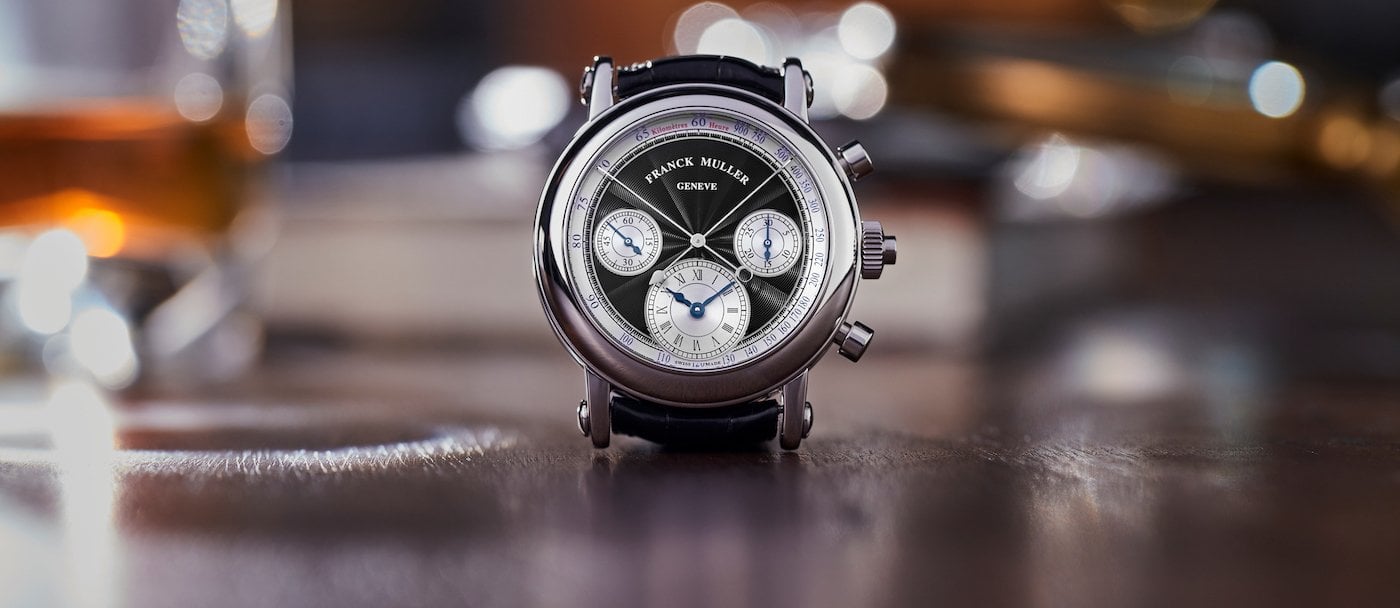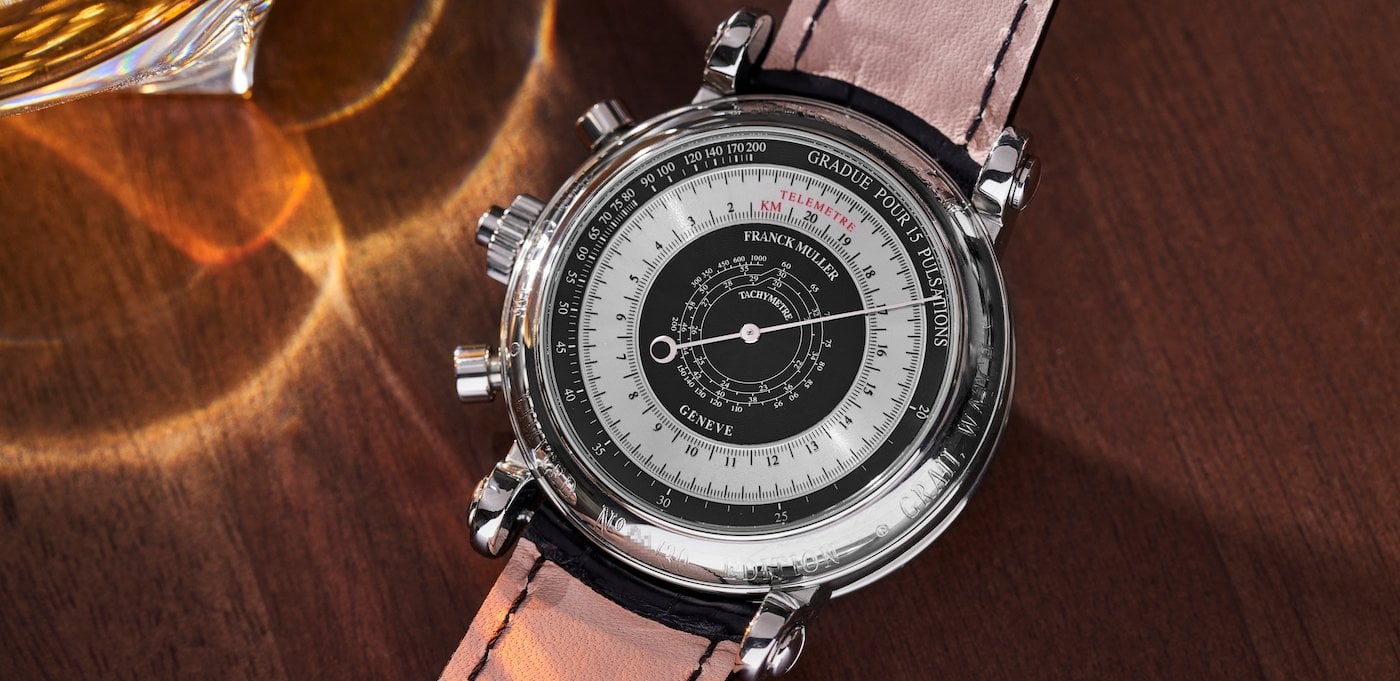ranck Muller entered watchmaking school at 15 years of age and literally blazed an incendiary trail, leaving many urban legends in his wake. One of the most famous is that after winning a Rolex watch for achieving the top prize at the Watchmaking School of Geneva, he took that watch and transformed it - using just a few more wheels - into a perpetual calendar. He showed Rolex the watch, hoping to sell them his design. Unfortunately, they turned him down. However, over his early career, it appears he produced a few of these timepieces, one of which ended up on the wrist of Jay-Z.
In the ’80s, Muller worked with Svend Andersen, restoring many Patek Philippe vintage watches for both private clients and also for the Patek Philippe Museum. From 1984, Muller began to create his own wristwatches, including the first tourbillon with the whirlwind mechanism on the dial side. In 1991, Muller launched his eponymous brand and, for a solid decade, was totally unrivaled in the realm of complicated innovations.
Amongst Muller’s most famous watches is the Master Banker, which allows the reading of three time zones simultaneously, where all three zones are infinitely adjustable and can be easily set using just the crown. Muller was the first to create a truly emotionally expressive watch with his famous Crazy Hours, a watch with an apparently random jumble of digits on the dial that always tells the right time. He also set the stage for his manufacture’s status as the king of the tourbillon complication with his Revolution 1 to 3 complications.

But of the various complications, Muller was truly passionate about the chronograph. His most famous interpretations of this complication are his Double Sided Chronographs.
He explains, “I always loved chronographs and was fascinated that using this sweeping seconds hand, you could read so many different types of information. You could calculate your average speed over a kilometer or mile with a tachymeter. You could calculate a person’s heart rate within 15 beats using a pulsometer. And you could gauge the distance to a physical event (you start the chronograph, for example, when you see lightning strike and stop it when you hear the sound) using a telemeter. But the problem for me was that I always wanted to have all this information on a single chronograph. There are some watches that place multiple scales on the dial of the watch, but that ends up being very messy and hard to read. One day I had the idea of creating a chronograph with two dials, one on the front and one on the back of a watch. Then I would create a longer pinion connecting the chronograph hands on both dials. The advantage would be you could use the second dial purely for the scales, combining a tachymeter, telemeter and pulsometer so they were truly visible.”
In recent years, these Franck Muller Double Sided Chronographs are gaining a following. While these were made in different versions, the most interesting amongst them are the split seconds or rattrapante iterations - for one very intriguing reason: Franck Muller created a modification to the Valjoux 7750 movement to incorporate this split seconds function for his watches. He had devised his own version of the Valjoux-based split seconds movement, which is called the Franck Muller caliber 7000.
So what about the Breguet numeral, Lemania-based Franck Muller Chronographs?
Says Silas Walton, founder of A Collected Man and the first person to recently identify, piece together the history of and sell these watches, “What we do know about these Franck Muller Chronographs is that they emerged in the ’90s and were made in two configurations. There was a silver dial, two- counter version with applied Breguet ‘12’ and ‘6’ and applied dot markers. This watch was 36mm in diameter. And then there was a black dial version with three counters with an applied Breguet ‘12’ and applied dot markers as well, and this watch was 37mm in diameter.”

Says Nicholas Rudaz, CEO of Franck Muller Watchland, “These watches were all commissioned by an Italian retailer in the ’90s. They were made in small series of either 40 or 50 watches each time. In some versions, the number of the watch was actually printed on the dial.”
The design characteristics of these watches were a clear tribute to Patek Philippe — in the same way that the Roger Dubuis Hommage was clearly, as the name expressed, a nod to the legendary Patek chronograph references 130 and 1463 of the ’40s and ’50s. The cases were smooth and rounded with long elegant lugs and concave bezels. Pushers were pump-style while the crowns were large and flat.
Both the bi-compax and tri-compax watches featured the use of the Lemania 1874, a shuttle cam-operated, laterally coupled chronograph movement introduced to the Speedmaster back in 1968. This movement was the successor to the column wheel-activated 2310 designed by Albert Piguet in the 1940s, and because its cam was much easier to set up, it was considered more reliable.
Says Jean-Loup Glénat, head of design at Franck Muller Watchland, “We were really excited to work on this project. It tells the story of an important part of our history and shows how creative Franck Muller was in the context of the era. Immediately, we retrieved the vintage plans of the watch and started to discuss the designs.”
The first thing to discuss was size. “We decided that while the older watches were 36mm and 37mm in diameter, we would make our watches 39mm,” says Wei Koh. “At the same time, we would stay extremely faithful to the case of the original watches using the same style, finish and the type of flat, oversized vintage-themed crown and large capped pushers. We also tried to make the cases as thin as possible so that they would sit elegantly on the wrist. One thing we decided on immediately was to distinguish these watches from the ones made in the ’90s by creating fluted pusher caps, of the style used by François Borgel (purchased at this time by Taubert & Fils) when they made the cases for the 1463.”
“The second thing we decided was that, while being incredibly faithful to the dial design of the original down to the texture, precise typography and colors used, we wanted to inject a dose of slightly more Latin sex appeal.”
Says Glénat, “In order to do this, we played with enlarging the size of the applied Breguet numerals and applied indexes and subtly enhancing the sense of contrast from one section of the dial to the next. The idea was, someone would look at these watches and say, ‘Wow, the design is really dynamic feeling,’ even while not realizing it’s because we made these small changes to the details. It would be hard to understand why you felt this way until you examined the modern watch next to an example from the ’90s.”

TECHNICAL SPECIFICATIONS
Round Collection
Purity and sober design are the guiding principles of the Round collection. Its fine movements and classical sobriety emphasize the timepiece with all the attributes of a family heirloom.
Reference ND 39 CC 2 SILVER GRAIL WATCH BR
Case
Round case Stainless Steel Hand polished Sapphire crystal Water resistant up to 30 meters
Dial
Silver Grené Stamped guilloché with sun pattern 20 layers of translucent lacquer
Functions
Hours, Minutes, Seconds at 9 o’clock, Chronograph (Seconds on the centre, Minutes at 3 o’clock)
Instructions
Crown with 2 positions at 3 o’clock : 1. Winding. 2. Setting time Pusher at 2 o’clock : Start / Stop of the Chronograph Pusher at 4 o’clock : Reset at zero of the Chronograph
Movement
MVT FM 2759 Manual winding movement Power reserve of 40 hours 128 components 18 rubies Diameter: Ø 27.00 mm. Thickness: 5.90 mm Balance wheel fréquency set at 21’600 alternations per hour
Movement Decoration
Côtes de Genève on the bridges and the rotor Polishing on the recesses Chamfering of the bridges and pivots Soleil finishing on the rotor segment Satin finishing on the pivots Perlage on the main plate and the barrel cover
Buckle
Stainless steel buckle Hand polished







